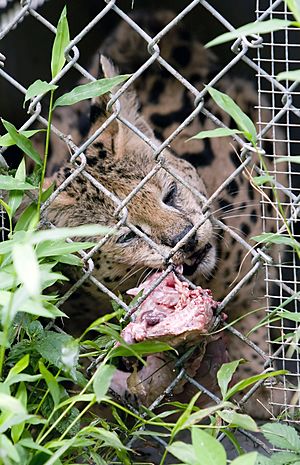Carolina Tiger Rescue facts for kids
 |
|
| Date opened | 1973 (Official) |
|---|---|
| Location | Pittsboro, North Carolina, United States |
| Land area | 67 acres (27 ha) |
| Website | www.carolinatigerrescue.org |
Carolina Tiger Rescue is a special place in Pittsboro, North Carolina, that helps wild cats. It is a nonprofit sanctuary, which means it's not run for money. They rescue tigers, lions, cougars, leopards, caracals, servals, bobcats, and other wild animals.
Lots of people visit the sanctuary each year. They come for guided tours, school trips, summer camps, and to volunteer. Carolina Tiger Rescue's main goal is to save and protect wild cats. They want all wild cats to live safely in their natural homes. This sanctuary is approved by important groups like the Global Federation of Animal Sanctuaries (GFAS) and the USDA. This means they follow high standards for animal care. Kris Marino is the Executive Director.
Contents
History of Carolina Tiger Rescue
Carolina Tiger Rescue started in 1973. It was first called The Carnivore Evolutionary Research Institute. A scientist named Dr. Michael Bleyman from the University of North Carolina created it. He wanted a place to study meat-eating animals (carnivores). These animals were very important to their environments but were disappearing.
Dr. Bleyman wanted to keep these animals safe. His goal was to protect them until their natural homes were safe enough for them to return. In 1981, the institute became an official organization. Its name changed to Carnivore Preservation Trust (CPT).
CPT became known for successfully helping animals like servals, ocelots, and binturongs have babies. As more people learned about these animals, groups started creating plans to help them survive. These plans included keeping track of how many animals there were. Because of this, Carnivore Preservation Trust stopped breeding wild cats in 2000. In 2009, they changed their name to Carolina Tiger Rescue. They then focused completely on rescuing animals.
Amazing Animal Rescues
Aria the Tiger's Journey
Aria the tiger was rescued in May 2013. Authorities took her from a family in South Carolina who had kept her as a pet. Aria was about 10 years old and very sick. She had lost a lot of weight.
When she arrived at Carolina Tiger Rescue, she weighed less than 200 pounds. This was about half of what a healthy tiger her size should weigh. After getting help from vets, good food, and proper care, Aria became a healthy tiger in just a few months.
Rajah and Kaela Tiger
Rajah and Kaela Tiger were found wandering on a road. They were near Charlotte, North Carolina and were only about six months old. Carolina Tiger Rescue took them in to give them a safe home.
Nitro the Blind Tiger
Nitro was a blind tiger who came to the sanctuary in 2009. He arrived with his friend, Apache. They were rescued from a junkyard in Kansas. This happened after a lion there attacked a man. The three lions from the junkyard went to the Detroit Zoo. Then, the search began for a home for the owner's two tigers. Luckily, Carolina Tiger Rescue was able to take Nitro and Apache. National Geographic Kids even wrote a book about Nitro!
Learning Programs
Carolina Tiger Rescue has many ways for people to learn. They offer educational tours and school field trips. They also have programs for homeschoolers and story time for preschoolers. Groups can also get special presentations. College students can even do internships there.
One of their main goals is to teach people about the dangers of keeping wild cats as pets. They also teach about the problems with circuses and other ways wild animals are used unfairly. Another goal is to help save wild animals in their natural homes. They do this by showing how palm oil farming can harm tiger habitats.
Safety at the Sanctuary
Carolina Tiger Rescue is a "no-touch" facility. This means visitors cannot touch the animals. They follow strict safety rules from the USDA and US Fish and Wildlife. These are important groups that set standards for big cat sanctuaries.
Guests must always be with a staff member when touring the sanctuary. They must stay at least three feet away from the animal enclosures. Employees or trained volunteers can briefly enter some smaller enclosures. This is for cleaning and maintenance. However, they are very careful not to interact with these wild animals. All staff and volunteers get a lot of training. This happens before they can work with the animals or go into any enclosure.
Working with Others
Carolina Tiger Rescue works with many different groups. They partner with universities, environmental groups, and other animal sanctuaries. They also work with businesses. For almost 20 years, they have helped the WildTrack project. This project collects information from tiger footprints without disturbing the animals.
Carolina Tiger Rescue was a founding member of the Big Cat Sanctuary Alliance (BCSA) in 2017. This group only includes real wildlife sanctuaries. The BCSA works to stop people from owning wild cats as pets. They also want to end the unfair use of wild cats in the US. Staff from Carolina Tiger also take part in the local American Association of Zoo Keepers (AAZK). Some money for the sanctuary comes from employee donations through groups like Earth Share of North Carolina.
Awards and Approvals
Carolina Tiger Rescue has received high ratings. Guidestar has given them a Platinum-level rating. Great Nonprofits has named them a top nonprofit every year since 2018. These ratings show that they are a trusted and well-run organization. As mentioned before, Carolina Tiger Rescue is also approved by the Global Federation of Animal Sanctuaries (GFAS) and the USDA.



